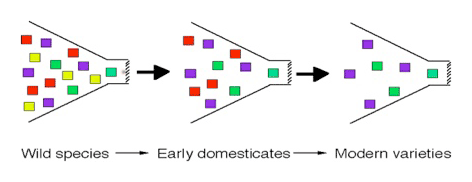What is domestication?
Domestication is the process by which plants and animals are genetically modified over time by humans for traits that are more advantageous or desirable for humans. For example, if a human notices that one particular plant in the field is taller, and taller plants are considered more valuable, s/he may choose seed from that plant from which to grow new plants. Since the individual plants selected likely contain gene for the trait they were selected for, their progeny (children) are more likely to inherit that trait. A tall plant is more likely to have taller progeny. Over time, if only tall plants are chosen as progenitors, more and more plants will be tall.
Our human ancestors began this process by selecting teosinte (the ancestor of maize) that had bigger kernels, and more rows of kernels. Over time they probably also selected for other useful traits, such as kernels that didn’t shatter (fall off from the plant), exposed kernels (lacking the outer protective part of the kernel) and higher-yield. Eventually, a new type was formed - what we know now as maize, or corn (see also Domestication genes).
Because the traits selected for are advantageous to humans but not necessarily advantageous for the plants, these newly developed plants have often lost the ability to survive in the wild without humans. For example, the large kernels of contemporary maize ears are not easily dispersed by wind or birds. If left alone in the wild, they would simply fall to the ground, where they would sprout in a heap, too close together to be able to grow into big healthy plants. And while some plants seeds are dispersed through ingestion by animals (and then expelled with feces), maize kernels are more thoroughly digested such that they are no longer viable when expelled (they have lost the hard seed coat that their ancestor had); thus, they cannot be dispersed in this way.
Some of the traits that have been selected for by humans but which are not healthy for a plant in the wild include:
- Retention of mature seed on the plant (loss of grain shattering)
- Synchronous ripening, shorter maturity
- Lower content of bitter tasting and harmful compounds
- Reduced sprouting (higher seed dormancy)
- Larger seed or fruit size
- Elimination of seeds, such as in banana
Since only certain plants are being selected and propagated, domestication tends to decrease the genetic diversity of the cultivated varieties of crops (see Figure below). Because consumers prefer uniformity in the marketplace, they “select” for low genetic diversity. But low genetic diversity can be detrimental (see later section). Diversity usually remains in the wild relatives of the crop species, however, and can be reintroduced by intentional plant breeding. Domestication is the same process used to breed new types of dogs, cats, livestock, etc.
Definition: Seed dormancy is a condition that prevents seeds from germinating under certain conditions. There are many mechanisms involved and varying conditions necessary to break dormancy. In the wild, dormancy helps ensure the survival of the species by spreading germination out over time (not all the seeds germinate at once), thus at least some seeds are likely to encounter a favorable environment and survive. In domesticated plants this trait has often been bred out because it is more advantageous for a farmer to have all seeds germinate at once, making the crop more manageable.

Domestication tends to decrease genetic diversity, as only certain plants are selected and propagated.


